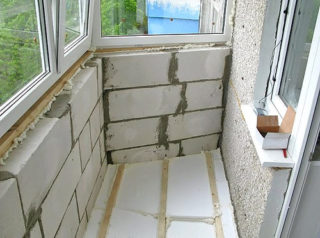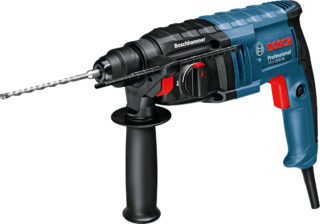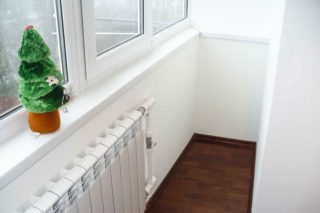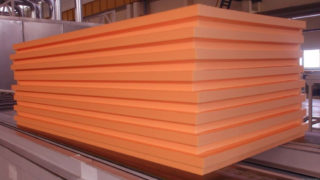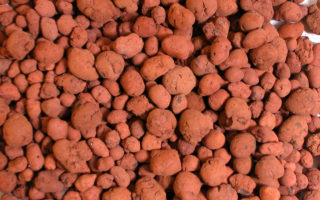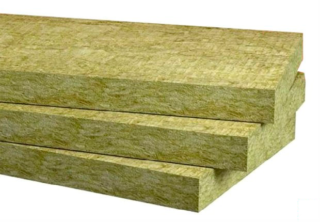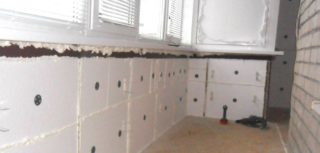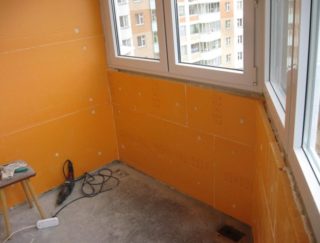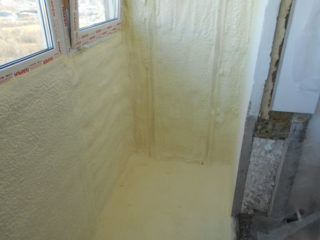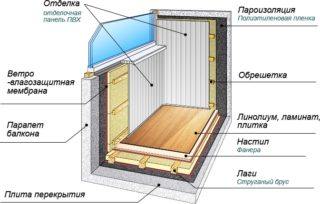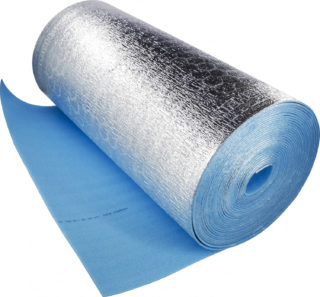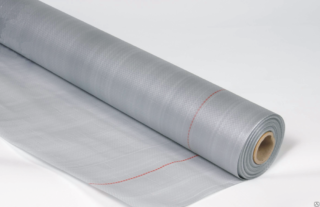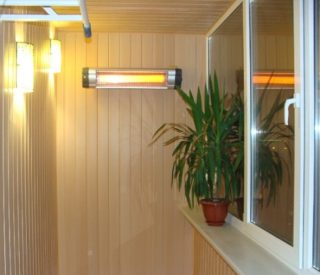If you consider the balcony as an additional living space, you need to do its warming. With a simple lining, the cost of the repair will cost about 45 thousand rubles, and with the use of insulation - 60 thousand. It is more profitable to warm the balcony fully with your own hands, so as not to pay the masters and make it a rest room or work room.
Preparation for balcony insulation
Before the start of insulation work, the balcony or loggia is glazed. You also need to decide whether to combine the balcony with the room. Next, you can proceed either to the insulation measures themselves, or to breaking the wall and removing finishing materials.
Immediately you need to prepare construction garbage bags. They will need at least 10 pieces - on tiles, plaster, so that then nothing falls off in the process. Everything must be thoroughly cleaned and removed so as not to interfere.
From the walls you need to pull out all the nails and sharp objects that can damage the insulation. Repulse various convexities of concrete with a hammer, cover the cracks with a concrete mortar until smooth, so that there is no blowing from the outside. The corners are aligned with the help of printed wooden battens - further this will affect the appearance of the loggia.
After all the preparatory work, it is necessary to coat all surfaces with an antifungal agent - you can buy it at a construction supermarket. Depending on what material will be insulated, it may be necessary to treat the wall with a primer. For example, before sticking polystyrene foam such an event is required.
Tools for work
In order not to interrupt the process of warming the loggia with your own hands, it is recommended to prepare all the necessary tools:
- building level;
- hammer;
- drill;
- punch - for removing plaster and concrete that has solidified unevenly from the walls;
- a knife for cutting insulation - it is recommended to buy a special one with a long nose in the thickness of the material;
- stairs.
For some types of insulation, the wall should be as aligned as possible in order to glue them to the surface qualitatively without the formation of air pockets. For this, we need a building level. A package of cement and sand, as well as a trowel for applying mortar to the walls, if it is not even, can also be useful.
When installing insulation boards on dowels, it is necessary to prepare several sets, depending on the size of the sheets. If you do not want to make holes in the materials, tile glue is suitable, but only for hard plates.
Tape suspensions or a frame for insulation are rarely done, because you do not want to part with the usable area. But if this option is selected, you need to buy wooden or aluminum rails.
Restrictions on insulation
It is impossible to carry out the following manipulations when warming a balcony or a loggia:
- Demolish load-bearing walls - this may result in a collapse of the structure.
- To start heating on the balcony.
- Equip a bathroom in the loggia, since there are no sewer pipes in this room.
- Change the height of the ceiling by applying an additional layer of concrete - this can cause the collapse of the upper balcony.
It is possible to make a kitchen on the balcony, but only with the permission of construction organizations, after calculating the load.
If the building is an architectural monument, all glazing and exterior modernization work is prohibited by law.
Basic materials for insulation
There is a huge amount of materials with which you can insulate the balcony from the inside. You should choose according to the following parameters:
- Cost. The most expensive, but really working material is extruded polystyrene foam.
- Climatic features of the region. What insulation will be most effective in winter.
- The building material of which the building is made. Brick and foam concrete hold heat better than concrete panels, so the insulation layer can be made smaller.
- Resistance of heat insulation to environmental conditions - ultraviolet rays, frost, rain.
Personal preferences may ignore all of the above options. If a person has heard a lot of good things about polystyrene foam, it will be impossible to convince them to supply expanded polystyrene even if there is money for expensive and durable material.
Expanded clay
Expanded clay is a specially processed clay. It is heated to 1000 degrees, after which empty spaces form inside. This air is a barrier that does not allow cold or heat to enter. Clay is one of the most environmentally friendly and durable materials. It is used for floor insulation on the balcony, as well as in private buildings for the foundation and walls.
In addition to thermal insulation, expanded clay reduces the speed of sound waves that are delayed by the porous structure of the substance.
Mineral wool
Mineral wool is of several types - glass wool, basalt stone, slag. For work on the insulation of the balcony it is recommended to use stone wool of medium density, between the fibers of which there is air. This will solve two problems at once - sound insulation and heat leakage, since there is little air in high density stoves and they serve only for thermal insulation. Stone wool is a non-combustible material, it does not accumulate moisture, but it passes water molecules well in the form of steam from the room. Basalt wool serves up to 50 years with proper installation and operation.
Glass wool has parameters slightly worse in water repellent characteristics. The same goes for slagging. These materials melt at 300 degrees.
It is imperative to work with glass wool in equipment, since the fibers crumble and fall into the eyes, on the skin, causing itching and redness.
Styrofoam
Polyfoam 90% consists of air. This explains its low cost and popularity as a heater for balconies. You can choose in any form - tiled, loose, liquid. Plates come in different thicknesses and densities. Foam is suitable for walls and floors, as well as for ceiling insulation. It is necessary to take care of the evenness of the walls in order to glue the plates, or knock down a wooden frame in the thickness of the plates and lay them there. In the future, the entire formwork will need to be covered with plaster.
Extruded Styrofoam
Extruded polystyrene foam is a modified polystyrene, but its structure is finer - the delimited air bubbles are smaller than that of the foam. Therefore, the material holds heat better and less passes sound. For him, there is no need to equip steam protection, since expanded polystyrene does not allow moisture to pass through.
The density of polystyrene foam allows it to be glued in the form of plates, and then to cover the joints. You can make a lock at the junction of the plates, so as not to violate the heat-saving properties. The material serves for a long time, without reacting to changes in temperature outside the window, humidity, but is expensive.
Polyurethane foam
This is a modified foam rubber with slightly different properties - it is more durable and dense. Suitable as insulation for balconies. It is most often used in the form of foam for spraying onto surfaces that need to be insulated. The foam layer will depend on the material of the walls, as well as the climate of the place of residence. The plus is that polyurethane foam creates a monolithic frame through which cold air masses do not penetrate.
Penofol
One of the new materials that has proven itself in the market of insulation. The plus is that you need a thin layer to create a barrier to cold masses or hot air in the summer. On the one hand, it is foamed polyethylene with air-sealed capsules. On the other, a foil is glued, sanded and reflecting heat.
When installing penofol, the foil side should be directed into the room in order to retain the heat coming from radiation sources or batteries.
Minus - the material is soft and not suitable in those cases when it is planned to apply plaster over the insulation. On top of the penofol, you can install drywall or some solid insulation, for example, basalt cotton wool, on which the mixture for plaster lays well.
Do-it-yourself insulation of the balcony and loggia
Warming of the loggia or balcony is recommended to start from the ceiling and move in the lower direction. It’s easier if the balcony is located under someone, then there will be less activities. If the apartment is on the top floor, the procedure is as follows:
- Apply a soundproofing film or spray spray.
- Waterproof the ceiling with a PVC membrane. There are the same, but made of polyester.
- The following is a wind protection membrane. This is a vapor-permeable material, but it retains air masses that can penetrate when cracking cement between bricks or joints of concrete slabs.
- Material against condensation. This is necessary so that the glass wool insulation does not absorb moisture. It is not laid only in the case of the use of hydrophobic heaters.
- The frame follows, but it is not necessary to do it if the insulation is put on glue.
- A layer of insulation to choose from.
- Vapor barrier.
After the ceiling, you need to do floor insulation. How to insulate the balcony below:
- First of all, waterproofing is laid on the floor. Soft materials are suitable - polyethylene, penofol. Penofol for the floor is better to choose two-way. With a one-way reflective surface should be directed downward. To connect penofol use aluminum tape. All joints of sheets of polyethylene are connected with plumbing tape to be sure of tightness. If you use bitumen mastic as a waterproofing, after applying it you need to wait a day before proceeding with further work.
- Next, you need to bring down the logs from the tree. The beam should be well dried and treated with antiseptics against the fungus. The distance between the lags should be equal to the size of the insulation plates so that they fit snugly. The height may be slightly larger. The cracks that sometimes occur between the lags and the walls of the balcony are filled with foam.
- The last heater is laid. It is important that there are no gaps between the boards and plates.
How to insulate a loggia on the walls:
- The first is a waterproofing layer that fits along the entire perimeter.
- If the insulation is fixed to glue, wooden beams made of wood are not needed.
- Insulation plates are laid around the entire perimeter in a frame or on tile glue. It is recommended to use several types of materials, for example, mineral wool and polystyrene.
- If cracks form due to an unevenly framed frame, they are blown with a mounting foam.
- The last is a vapor barrier layer.
External walls are subject to more severe insulation. It is recommended to lay at least 2 layers of thermal insulation material.
If old wooden windows are on the balcony, they must also be insulated for the winter to avoid heat loss. Here, special plaits made of foam rubber or foamed polyethylene are suitable, which are laid between the window structures.
Additional insulation methods
In regions with a cold climate, one insulation in the walls will not be enough. On the balcony you can install a conventional electric heater - oil, infrared, which is sent to the wall, or a fan heater.
If possible, you can buy a warm substrate, arranging a warm floor. For example, the Caleo system manufactured in Korea. Turn it on as needed.
Air conditioning with a warm air function will help to warm a large area balcony. In summer, it can be switched to cooling mode. The downside is that this will entail additional costs for electricity, while the floor will not warm up. According to the laws of physics, warm air from the floor will rise up, heating the entire room, so a one-time financial investment in the floor is still more profitable than an air conditioner.
Another negative point of the hermetically sealed balcony is the lack of ventilation. This can be solved by installing the Breezer system, which delivers fresh air from the street, preheating it to the desired temperature.
Common errors in warming
Most people start warming balconies and loggias before the very cold, so all activities are done in a hurry. Often the process is limited to blowing slots with foam. Concrete, brick, and other brands of building materials do not isolate heat as efficiently as special heaters do, so warm air will continue to disappear into nowhere.
Saving on your own home can only be justified in the case of discounts on quality materials in the store, for example, leftover goods. Otherwise, it is not recommended to buy cheap heaters - they will cease to fulfill their functions after a couple of seasons.
The lack of an action plan for the modernization of the balcony leads to the fact that important points are released, and the work is done poorly. It is necessary to think over and calculate how much what is required for the installation of thermal insulation, how long it will take, only after all calculations to get to work.
